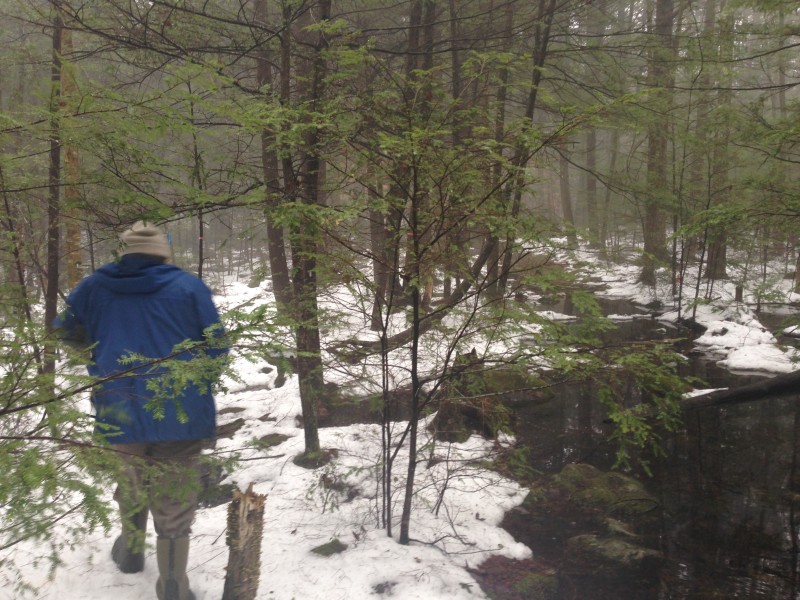The world’s first tweeting tree! @awitness tree now on Twitter
September 10, 2019
Wired with sensors, the Witness Tree at the Harvard Forest is now live tweeting from the forest — to more than 7,700 followers and counting.

The world’s first tweeting tree already has more than 6,500 followers @awitnesstree
The brainchild of Tim Rademacher and his team at the Harvard Forest, my tree now is transmitting data from sensors that track everything from its growth rate to temperature and sap rise to tell the world — in conversational language — about what it is up to, day to day. The tree’s posts are also contextualized with 55 years of climate data at the forest.
The tree has agency: its uploads of data drive what is posted. But credit Clarisse Hart at the forest for the tree’s graceful prose. Thanks, Clarisse.
Live tweeting takes the tree’s real time presence to a whole new level — this is a look inside the day-to-day life of the tree. Nothing like it has ever existed before. What I love about it is the way it makes tree physiology and forest ecology real. Approachable, and fun.
And there’s more, with sightings from the wildlife camera right by the tree to show who’s in the neighborhood (take a look at that sassy fox spotted recently) to the opportunity to ask the tree how it is doing and get an answer. This is a whole new way to get deep inside a tree — literally.
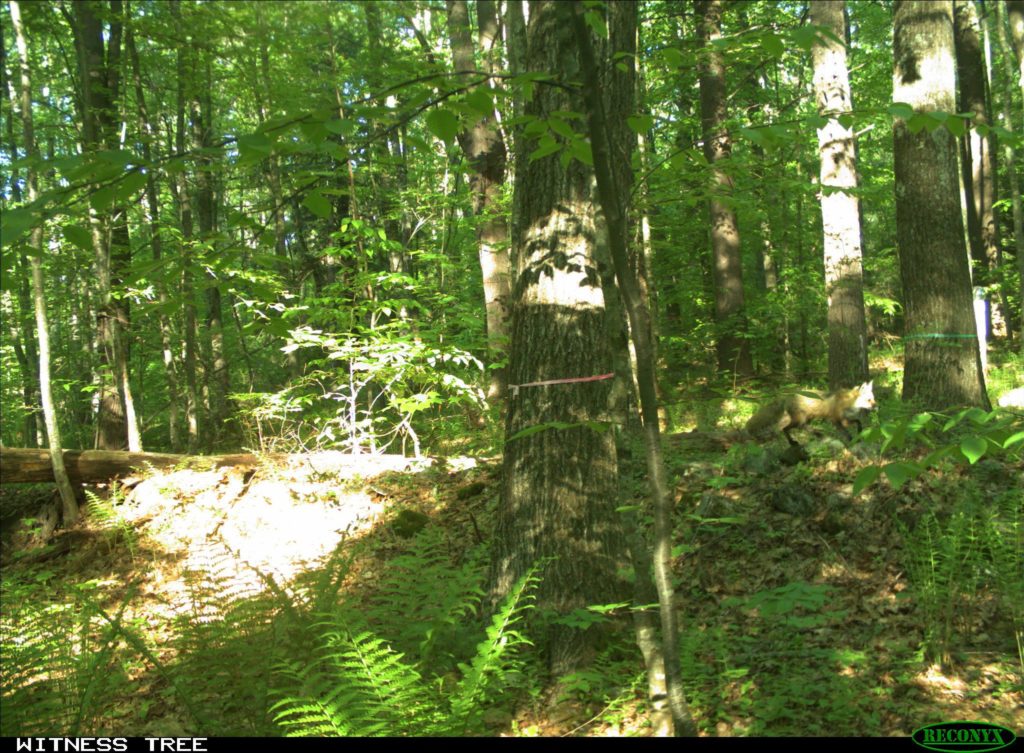
It’s been a sensation, with media around the world picking up the story. Have a look — follow the tree, and ask it a question!
With kudos to the crew at the Harvard Forest for thinking it all up and making it happen. Here’s the inside scoop on that.
Thanks also to the crew at the Harvard Forest for keeping the web cam going strong under the tree now since 2014. That’s impressive in a forest especially with New England weather.
So now when the tree tweets, you can have a look at the webcam too, and see the tree and its lived experience in the forest. Facebook is next.

The Witness Tree in full glorious green leaf on September 9, 2019. No hint of fall yet.
Last bit of recent news is Witness Tree Seasons of Change With a Century Old Oak What One Tree Tells Us about Climate Change is now out in paperback. The University of Washington Press did a beautiful job with the newest edition.

Now out in paperback! Published by the University of Washington Press, at bookstores everywhere as well as online.
A FIRST SPRING WALK – IN THE SNOW
April 16, 2018
Fog slinks low over the snow as John O’Keefe heads out into the forest, beginning his 29th year of survey walks of his phenology trail at the Harvard Forest.
The temperature’s in the 50s, creating a conversation between the air and the still snow-patched ground spoken in a whisper of fog.
The purpose of this walk is to set a baseline as John looks for earliest signs of spring. From now till the leaves are once again fully out on the trees, he’ll check these same 50 trees and shrubs he has closely watched for nearly three decades, recording the seasonal rhythms of nature. His work, meticulously recorded with No. 2.5 pencil on data sheets, has built a nearly 30-year record of consistent observation of the seasonal changes in this forest, used by scientists around the world to detect the impact of climate change on the land.

John O’Keefe heads out for his first survey walk of 2018, beginning his 29th year of observations at the Harvard Forest
We’re sliding around on the snow as we head out on the trail. The brook under the bridge we first come to is running hard. In the pasture just before we head into the wood, cows stand at the fence, with one intrepid member of the herd stretching her head through the slats of the fence to snag hay from the bales stacked for their meals. Good girl.
John finds one of the first trees in his survey, an ash, rising straight into the grey sky. It’s not yet budged from winter into spring, its buds tight clenched. I feel my foot roll and look down: there is a paving of acorns everywhere. Wintered over, they are swelling with spring rain, splitting their shells, and showing the pink delectable nutritious nut within. A root reaches from the split shell, hungry for soil.
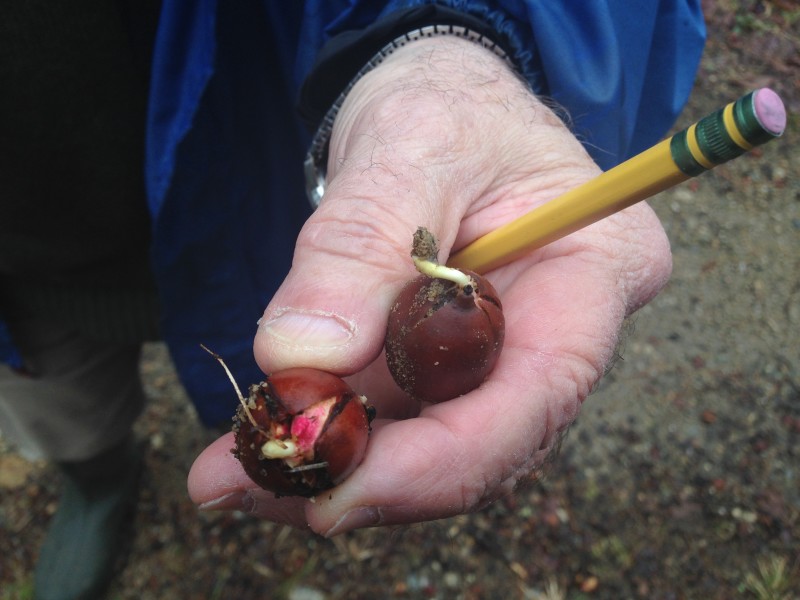
John holds some of the acorns rolling around under our feet. The shells split, the roots reaching for soil, these acorns are just so eager to become oaks.
These mast years come about every five years, and are a fiesta in the forest, providing a surfeit of acorns that stuffs more than 100 species of wildlife. It’s nature’s way of making sure enough acorns survive to sprout. Overwhelming the locals every now and then with more than they can possibly eat has created this surprising ball-bearing ride as we walk along. I can’t believe the bounty.
The woods, which seem grey and still dormant when quickly glanced at through a window indoors, on closer inspection out here are wonderfully alive. Last night’s warm wind brought a Big Night — the first movement of amphibians to their breeding ponds. And even as we walk, John steps carefully out of the way of a red eft, a juvenile salamander somberly making its way across the forest duff.
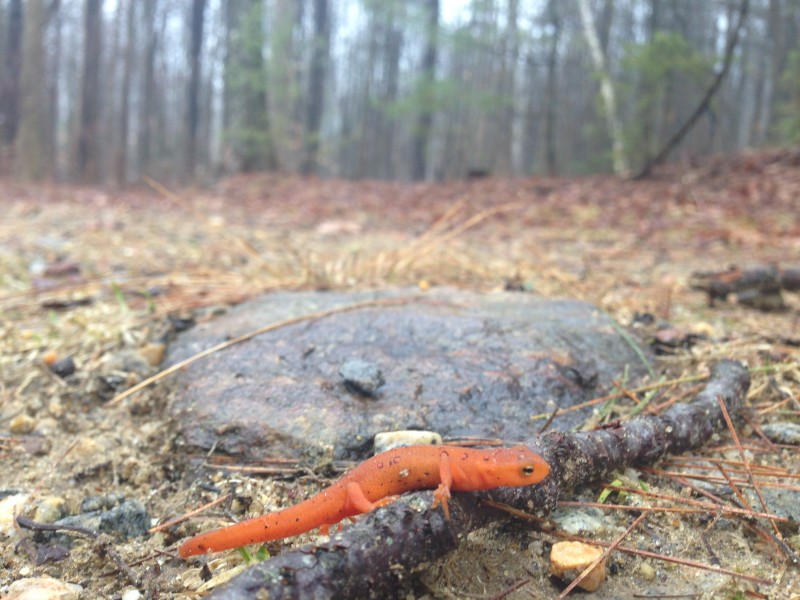
A red eft stoically makes its way across the forest floor, undaunted by obstacles.The warm spring rain brings them out in their first forays of the year.
John’s walks show a long term trend toward earlier springs, and later falls, with a growing season stretching longer and longer.
The seeds of a black birch pepper the ground, along with a scatter of pine needles, still fresh and green, the wind must have brought down in the night. John bends with his ruler to record the depth of the snow in a patch that always is among the last on the trail to melt out, and records 14 centimeters. Open to the sky, it’s a stretch of the trail that gets the most snow, and, in the shade of a stand of conifers, gets little sun.
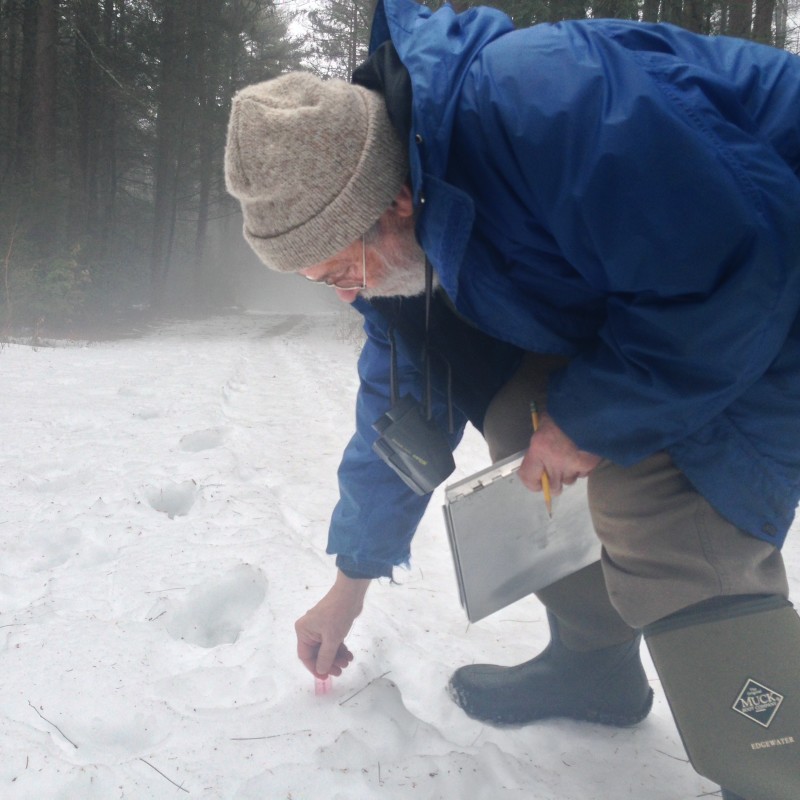
The first survey walk of the year always includes some snow. This year is no different, as John pokes a pocket ruler through the fog ghosting over the snow to note its depth. He records all aspects of the seasons, from bird calls to the state of the trees’ seasonal development, the animals we see, the condition of the understory and canopy, using binoculars not to miss a detail. His handwritten logs are an intimate record of the heartbeat of the forest, season by season.
We come to a pond deep in the hemlock woods and it’s still quiet: no wood frogs, among the earliest to sing, are yet calling for mates. But the first ribbon of open water shows black along the white lid of snow stacked on the icy pond. With that first open water, it won’t be long now.
John pushes his thumb against the end of a long beech bud: it’s still sharp to the touch. No plushness has yet come to the bud case, the leaves are still embryonic within. The leaves of last year, the color of just-right toast, still tremble in the wind. Beech is the last of the trees to lose its leaves, pushed off with the year’s new growth.
A soft spring rain begins to fall, and John hunches over his paper, struggling to keep it dry as we walk. Blue jays fuss and a robin announces the season.
We pass behind the barn and head to the trees under the scrutiny of cameras high on a tower, watching for their seasonal changes. Part of a network of 400 cameras in a network around North America, they create a virtual observatory by which to document seasonal change. Together with the records of human observers, including John, the cameras are opening discoveries about the relationship between climate change and the physiology of the forest as seasons re-wind the timing of spring and fall.
Andrew Richardson, formerly of Harvard University and now at Northern Arizona University at Flagstaff, recently published a paper that describes the network, the result of a 10 year collaboration with colleagues at Boston University and the University of New Hampshire. Already recording millions of images, the cameras create a continental observatory without precedent.
The data gives scientists plenty to chew on, assessing the effects of climate change on everything from temperate deciduous forest, such at this one at Petersham, MA, to tropical grasslands in Hawaii, coastal wetlands, arid scrublands, and evergreen Boreal forests. In addition to being scientifically useful, many of the photos are just plain beautiful. Go ahead, have a bird’s eye tour of the continent on the Richardson Lab’s web page.
In a blog post about the network, Andrew says he and his collaborators stumbled on the idea for the network by accident. Good thing. The paper Andrew just published with a team of collaborators who’ve worked on the network for years provides open access to the data. It will be fascinating to see what emerges from it all.
And with each step, each notation of his pencil, John keeps compiling the ground truth behind the cameras, as here at the Harvard Forest the trees get ready to take their first vernal breaths. Eternal, reassuring, the cycle of the seasons is underway. Different, changing, yes, as I describe in my book about John and Andrew’s work and so much more at the Harvard Forest, Witness Tree. But how lovely to watch the forest stir back to life in this earliest spring walk, with the buds just beginning to blush on the red maples.
Hello, Wyoming
January 17, 2018
I did a lot of radio interviews when my book Witness Tree came out and sure enjoyed that. Here is a pod cast with Wyoming Public Radio that really captured the joy of the Witness Tree story, seeing the extraordinary in the ordinary of that red oak tree — and the truth of the climate change story revealed in nature.
As New England has endured its snow bomb it’s been weirdly warm here in Seattle, where I live, just as it was when I was at the Harvard Forest writing Witness Tree in the winter of 2014-15. We had snowmageddon at the Harvard Forest while back home people were cutting the grass by March. This year seems to be headed in a similar direction, friends are already hearing spring frogs south of us and the daffodils are up four inches. The witch hazel in our front garden is in full bloom.
The big oak has made it through the bomb cyclone and I’m glad for that! I’d show you the picture on the Witness Tree web cam at the Harvard Forest of it standing tall…but the cover over the camera is covered with snow! As it should be.
Meanwhile tree stories continue to fascinate me. Here is a piece I wrote in the Seattle Times last week about the death of a beautiful, old American elm. It stood for a century and now only its mate remains, its crown holding the shape of the departed. As in any long marriage, they formed one another and the remaining elm shows the reach of its mate’s arms, where they stood together side by side, for so long.
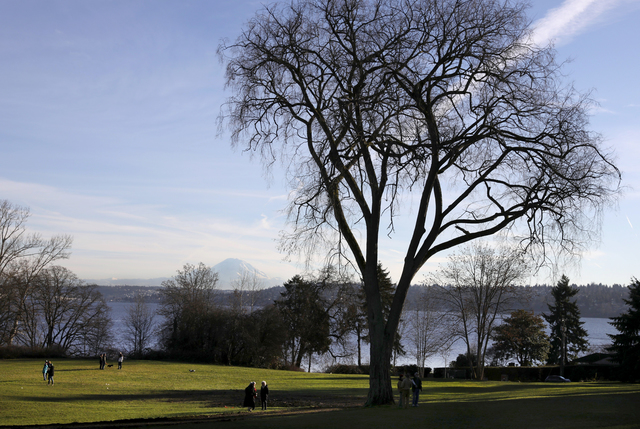
The remaining elm shows the shape of its departed mate, on the left side of the crown. It shows the reach of the arms of the tree it stood next to, for so long. (That’s Mount Rainier, in the background.) Credit: Ken Lambert, The Seattle Times
As elsewhere, the elm had been maintained with expensive injections of anti-fungal treatment to stave off Dutch Elm Disease, and was perfectly healthy. But the soil became so saturated in one of our famous Seattle winter rains that a winter wind storm at the stub end of the year blew it right over.
One of the things that made that big elm so special was its crown tumbled in green tresses all the way to the ground. So people could touch and know the canopy even of a very big tree.
Here it is, still standing with its mate, as it received what turned out to be its last treatment.
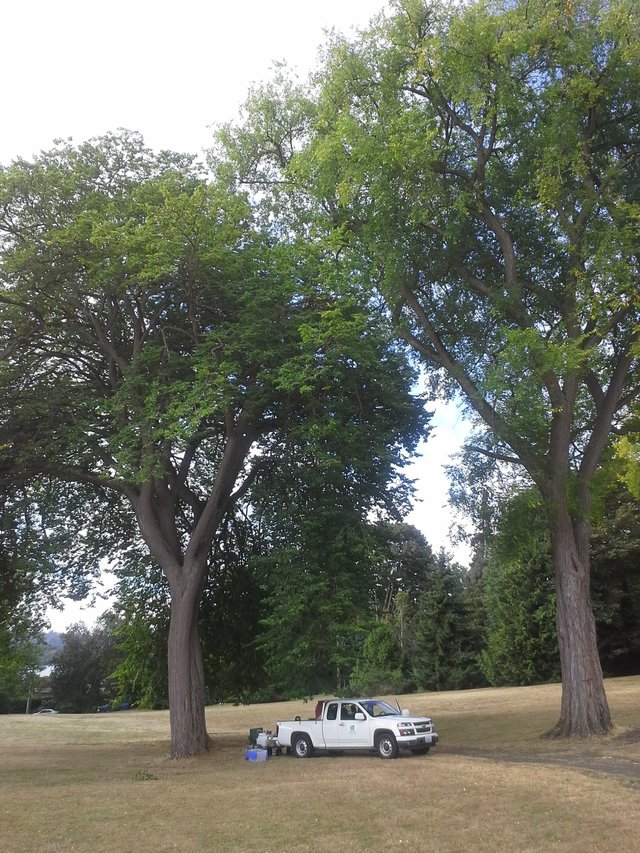
The elm on the left was toppled in a wind storm. It was one of the largest American elms left in Seattle’s city parks and sustained with anti fungal treatments, such as it is receiving here. Photo by Deborah Brown McGarry.
So that is how it is with trees. They enter our lives, then our hearts, and stay there. One of the joys of writing Witness Tree is how many people have sent me photographs of favorite trees, very often trees they grew up with as children. I treasure these stories. You are invited to send me yours: lmapes@seattletimes.com
New York Times Book Review: another great shout out for Witness Tree
May 31, 2017
The June 4 edition of the New York Times Book Review includes a wonderful recognition for Witness Tree, in a round up of books about the outdoors:
“The intriguing, and more intimate, WITNESS TREE: Seasons of Change With a Century-Old Oak (Bloomsbury, $27), by Lynda V. Mapes, portrays trees as “scribes, diarists, historians.” They are “among our oldest journalists.” A reporter herself, covering environmental issues for The Seattle Times, Mapes sets out to tell the story of climate change through one tree. But that is, marvelously, the least of it.
She finds her oak in the Harvard Forest in Massachusetts and spends a year with it, telling of the farm on which it grew, twisting up out of a stone wall, and drawing forth people devoted to befriending and studying trees. They are the tree’s interpreters. Bob Leverett, a former Air Force engineer and a “committed big-tree hunter,” arrives to take measurements and tells Mapes, “I need trees for my emotional stability and health.” He bemoans all we have lost in the destruction of ancient forests: “We have robbed a species of its dignity.”
Mapes is a graceful writer. She describes “the quiet finesse” of a tree; “the fructifying funk” at the base of an oak; the “wand of time” that is a core sample drilled out to ascertain age; the “choring and the weariness” in the diary of a 19th-century farmer’s wife; a spider that has “rappelled gracefully” off her glasses. She is spending so much time with her tree that it’s becoming a part of her; she sheds it only when she goes indoors at night.
The natural world is an unimpeachable witness, and we would be wise to heed its testimony. “We are not separate from nature,” Mapes writes, and in this she echoes what the artists and scientists and gardeners are telling us too. “We are of it, and in it, and we need an ethical framework to match.”
Delighted to see the book get this national recognition for the second time, the book review also gave Witness Tree a lovely mention in the spring books guide.
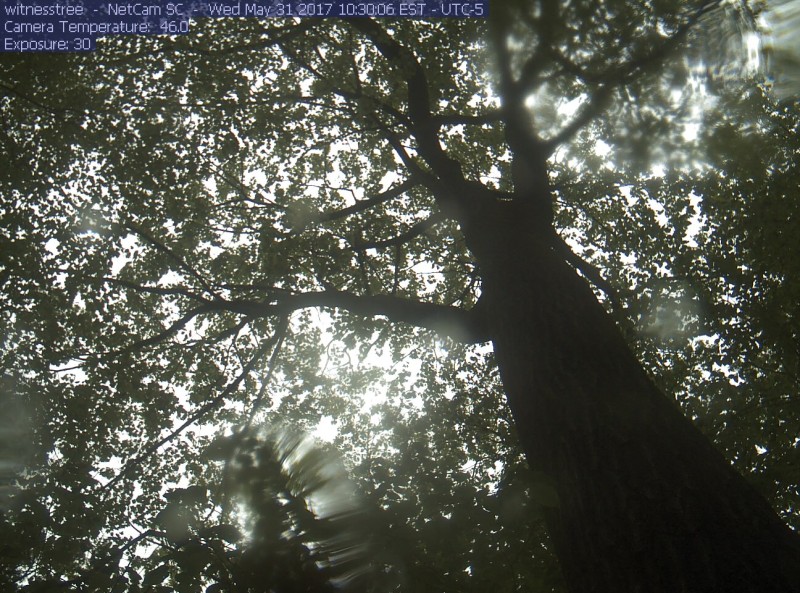
The Witness Tree, captured on the Harvard Forest web cam at its feet this morning, May 31. Notice the rain drops on the camera cover. The tree is now in its glorious green gown of leaves, ready to work for another season.
From walnut tree, to new life and purpose at the Arnold Arboretum
May 27, 2017
How honored I was to be the first author to present from the new lectern at the Arnold Arboretum fashioned from a walnut tree in its collection that had to be cut.
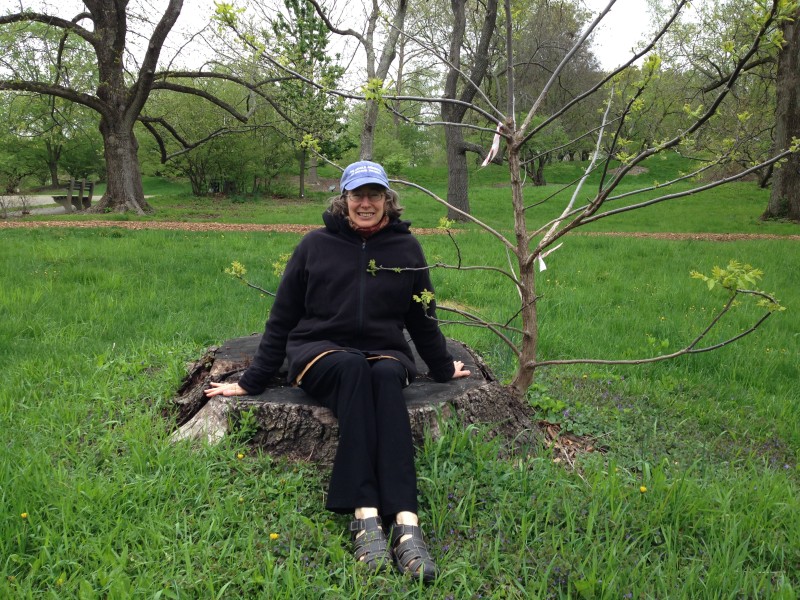
Me on launch day May 5 at the Arnold Arboretum on the black walnut that gave its life for the lectern, and a beautiful new conference table at the Arnold Arboretum. Note that it’s also got a new life all its own, in the new shoot burgeoning from its stump. Photo by Pamela Thompson
The tree survived minimal hurricane damage in 1985, and a lightning strike. A shoot is now growing from the remaining stump. And its life at the arboretum continues. For one, the tree’s uniquely beautiful wood has been fashioned into a new lectern for presentations at the fine gathering space in the visitors center at the Hunnewell Building at the arboretum.
Made from black walnut (Juglans nigra) by Pergola Construction of Swampscott, MA., the lectern is just one new life and purpose for the tree, accession number 14761*A, received as a plant in Dec 1893 from Thos. Meehan and Sons Nursery in Germantown, PA.
I was thrilled to read at the lectern — the first presenter to have the honor — during the launch for Witness Tree so graciously hosted by the arboretum May 5.

With Pam Thompson, left, manager of adult education at the Arnold Arboretum, and a copy of Witness Tree the night of the big launch, the first at the new lectern. And what beauty it is! Photo by Richard Maddocks.
One of the joys about the arboretum is the history in each named, numbered and tracked tree and shrub in the collection. I think director William (Ned) Friedman knows each one as an individual. On a visit to the arboretum earlier this week the two of us roamed the rain-soaked grounds for hours and it was a joy to watch him exclaim in the wonders unfolding as spring coaxed out new leaves and flowers in profusion. No administrator stuck behind a desk, Friedman makes a point of visiting the collection, photographing it, blogging about it, and knowing the condition of the grounds and plants up close, and personally.

Ned Friedman, director of the Arnold Arboretum of Harvard University, savoring the bloom on a horse chestnut. The collection was in peak flower during my visit May 22nd and a sight not to be missed.
But that is not the end of the story on the black walnut. When I came back to the arboretum that day after our ramble around the grounds Dr. Friedman showed me the new conference table, delivered just that day at the arboretum’s Weld Hill Research Building. What a glory that table is: silky smooth to the touch, grand, with every bit of grain and beauty revealed, it is a gift not only to the present, but the future.

The new conference table made from the same black walnut, shown off by Ned Friedman, arboretum director, and Faye Rosin, director, research facilitation.
And speaking of the Arboretum…be sure to read my story about the story behind my book Witness Tree, just published in the current edition, Vol. 74, No. 4 of Arnoldia, the science magazine of the Arboretum. Thanks to editor Nancy Rose for doing such a nice job with the story.
Terrific new podcast on Witness Tree
May 18, 2017
Thanks to Sam Hankin of WCHE 1520 AM’s Avid Reader for this great podcast on Witness Tree. Sam is the manager of Wellington Square Books in Philadelphia, a gorgeous independent book store. He was a prepared, smart, questing interviewer who created a lively, interesting new take on the book. Give it a listen!
Meanwhile there is news in the woods, too. Leaves! After an on again, off again spring that was both hot and cold, the big oak is finally resplendent in its new robe of leaves at the Harvard Forest. How beautiful to see when I clicked on the Harvard Forest’s web cam under the tree this morning from my study in Seattle, just to see how things were progressing. Ah, the pleasure of long distance phenology! Spring, with no black flies.
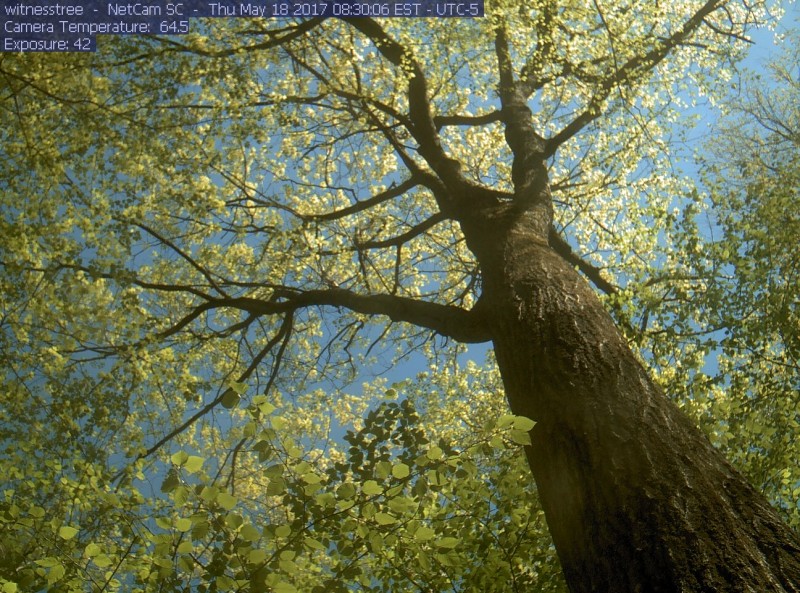
Here is the webcam photo from the Witness Tree Cam at the Harvard Forest from this morning, May 18. Spring has finally truly sprung.
More Great Press for Witness Tree
May 12, 2017
Thanks to Diane Horn of KEXP in Seattle for this podcast on Witness Tree. Thoughtful, insightful, in-depth coverage of the book.
Thanks to Carrie Healy of New England Public Radio who put up this great story today on New England Public Radio. She made the trip out to the Harvard Forest to interview me under the big oak and talk about the Witness Tree project. I love the sounds of us walking up to the tree and the spring birds calling as we talked!
Full of laughter and joy, she was a reporter who clearly got the unique setting of the Harvard Forest and the message of the book. What a pleasure to spend that time together.
Witness Tree at the Arnold Arboretum
May 5, 2017
Visiting the horticultural library at the Arnold Arboretum at Harvard University to prepare for my book launch tonight at 6 pm, who do I meet, but Larissa Glasser, library assistant and Lisa Pearson, head of the library and archives, on the very moments that they are taking Witness Tree into their collection at the library.
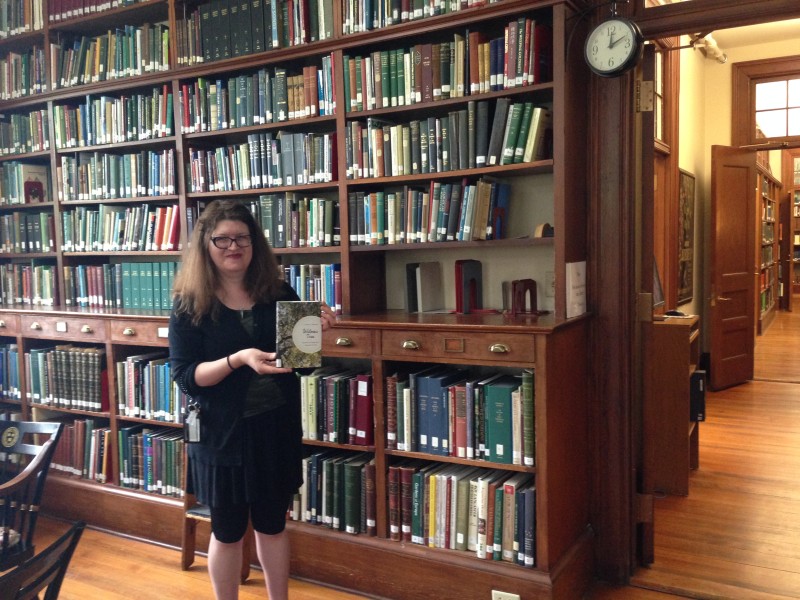
Larissa Glasser, library assistant at the horticultural library of the Arnold Arboretum at Harvard University about to tuck Witness Tree into the permanent collection.
Now, for authors, really truly it doesn’t get much better than that, especially this author. My career as a writer was launched as a reader, tagging along with my mother to the public library in Chappaqua, New York, where she would gather stacks of reading, and I would race down to the children’s section to do the same. Out we would come to her station wagon, loaded down with books ready for a nice long read.

Witness Tree has great company on the natural history shelf at the horticultural library at the Arnold Arboretum of Harvard University
I had my own library card from earliest age and could check out as many books as I wanted. Every birthday meant a new hard cover book. And libraries have been my haven since those early childhood days. Fast forward to publication of Witness Tree on April 11, launched at the Seattle Public Library and hosted by the Seattle Public Library Foundation among other partners. What an honor to be feted that night in that beautiful public gathering place for learning and discovery.
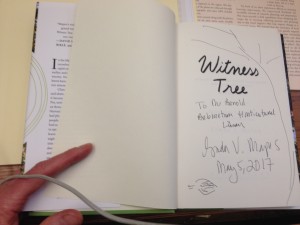
What an honor to sign Witness Tree to the horticultural library at the Arnold Arboretum of Harvard University.
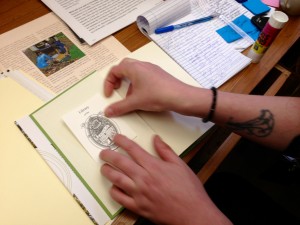
Such beautiful book plates at the Arnold Arboretum’s horticultural library! Dressing up Witness Tree.
And now, to watch Witness Tree get its barcode, label, and bookplate, to sign it with a flourish and see Larissa climb the book ladder to tuck it on the natural history shelf…right next to Aldo Leopold’s Sand County Almanac and Berndt Heinrich’s The Trees in My Forest — two books that inspired me in writing Witness Tree, how very wonderful indeed.
Particularly in this library. It’s open to the pubic, and even smells just as a library should: like old wood and books. Windows and views to the arboretum beyond make for a luscious setting, and the grand library table, so big it was built in place, and dating to 1892 make work here a special pleasure.
I don’t have a window in the cubical I inhabit in our mouse-infested mayhem of the newsroom at the Seattle Times, where I am the environmental reporter. It will be nice, when back at work to think of Witness Tree on these beautiful shelves, in this gracious room, with its vast library table and the swell little wooden ladder for climbing the floor-to- ceiling shelves. The soft light from the bubbly old glass windows, the grandeur of this salon of books. Ah yes. How wonderful indeed. But better yet, I like to think of Witness Tree checked out, busy in the world, with readers flocking to libraries, for wonder and discovery.
Climate change as told by one tree
April 30, 2017
Thanks to Warren Olney and the crew at To the Point for their wonderful show on Witness Tree. So fun to go on the air and tell the story of the big oak at the Harvard Forest.

Witness Tree is getting great press across the country. Great trees make great stories! Photo by Bellamy Pailthorp, KNKX
The Boston Sunday Globe magazine this Sunday April 30 also will have cover story about the Witness Tree. That’s a mighty warm welcome as we pack up and get ready to come to Petersham May 2 for the launch for Witness Tree at the Harvard Forest at the Fisher Museum at 7 pm. There will be a special presentation at the Six Bridges Gallery in Maynard on Thursday May 4.The Evening of Trees show from 7 to 9 pm features senior ecologist Neil Peterson from the Harvard Forest, photographs by Brent Mathison and I’ll read from Witness Tree and sign books. The week will top off with a launch at party at the Arnold Arboretum at 6 pm.
All events are free and open to the public. East coast friends hope to see you there!

